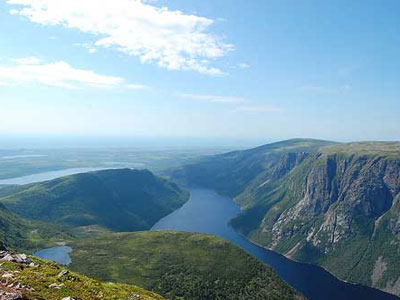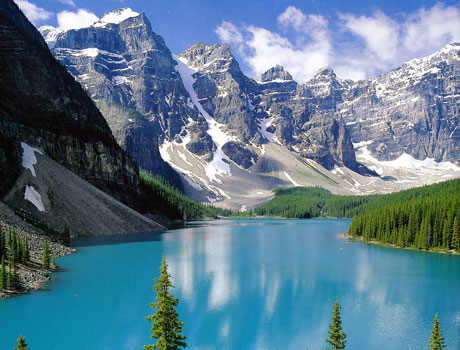Canada
Country statistics

Land area: 3,511,003 sq miles (9,093,507 sq km)
Total area: 3,855,102 sq miles (9,984,670 sq km)
Population (2009 est.): 33,759,742 (growth rate: 0.8%); birth rate: 10.2/1000; infant mortality rate: 4.9/1000; life expectancy: 81.3; density per sq km: 3
Capital City: Ottawa, Ontario
Monetary unit: Canadian dollar
Languages: English 59.3%, French 23.2% (both official); other 17.5%
Ethnicity/race: British Isles origin 28%, French origin 23%, other European 15%, indigenous Indian and Inuit 2%, other, mostly Asian, African, Arab 6%, mixed background 26%
Religions: Roman Catholic 46%, Protestant 36%, other 18% (based on 1991 census)
Country introduction

Canada is a North American country, located in the northern part of the continent and extends from the Atlantic to the Pacific and northward into the Arctic Ocean. Canada is the world's second-largest country by total area, and borders with the United States, making it the world's longest land border.
Canada has breathtaking sceneries, from the rugged eastern and maritime coastlines of Newfoundland and Nova Scotia to the exuberance and the splender of the French Canadian cities of Quebec, Montreal and Ottawa. Toronto is also home to Niagara Falls, a spectacle of wonder.
Canada has a very large and diverse range of geographic features. Boreal forests prevail throughout the country, ice is prominent in northerly Arctic regions and through the Rocky Mountains, and the relatively flat Canadian Prairies in the south-west facilitate productive agriculture. The Great Lakes feed the St. Lawrence River (in the south-east) where lowlands host much of Canada's population.
The culture

Canada is similar to the United States in that it is a melting pot of different cultures and religions. Due to its colonial past, Canadian culture has historically been heavily influenced by English, French, Irish and Scottish cultures and traditions. In more modern times, Canadian culture is now greatly influenced by American culture, due to the proximity and the migration of people, ideas, and capital.
Canada is a country without an official religion. Although about 70% of Canadian citizens claim to be practitioners of Christianity. However, the stark increase in immigration from areas such as Asia, Africa, and the Middle East has contributed to the expansive growth of Muslim, Buddhist, Sikh, and Hindu communities within the country of Canada.
The diversity and vastness of Canada is reflected in the festivals that are celebrated there. These include the comedy of the world famous Just for Laughs Festival in Montreal, Québec, over 44 cultural pavilions of the Folklorama Festival in Winnipeg, Manitoba, the Celebration of Light fireworks in Vancouver, British Columbia, and the Toronto International Film Festival in Ontario where there are plenty to offer travellers.
Many American movies, authors, TV shows and musicians are equally popular in Canada (and vice versa), many have been successful worldwide. Most cultural products from Canada are now increasingly marketed toward a unified "North American" market, and not specifically a Canadian or American one.
Canadian cuisine varies widely depending on the regions of the nation. The original population of Canada contributed to an emphasis in Canadian cooking on wild ingredients, including game, salmon, berries, wild rice and maple syrup. With subsequent waves of immigration in the 19th and 20th century from Central, Southern, and Eastern Europe, South Asia, East Asia, and the Caribbean, the regional cuisines were subsequently augmented. Slavic and Scandinavian immigrants brought their warming dishes to the Canadian heartland. Asian immigrants carried their style of cooking to the coastal cities.
Attractions & landmarks

There is a wealth of things to do and see in Canada. While the western part of Canada is known for its extraordinary natural landscape, the east is an interesting combination between the charm of Europe and the exuberance of New York City.
A major landmark not to miss is the Niagara Falls. It is situated in the province of Ontario and it stretches from the Big Lakes to the Hudson Gulf. It is considered the natural wonder of the continent and according to specialists it was formed 12,000 years ago during the Ice Age. It is without a doubt one of the best attractions in Canada, which attracts millions of visitors every year. Travelers who wish to see the spectacle benefit from parks, platforms and observation towers.
The majority of Canada is still wilderness and a great place to experience this is at the Algonquin Provincial Park, located between the Georgian Bay and the Ottawa River, close to the centers of Toronto and Ottawa. The area has become acknowledged by nature preservationists because of its stunning beauty. It is home to many year-round outdoor activities and it is also equipped with 1,200 campsites. Visitors can enjoy a fishing or horseback riding experience or simply view the beautiful landscape from the Algonquin Room.
To enjoy even more of the natural landscape that Canada has to offer it is worth visiting the Jasper National Park in Alberta. It is the largest National Reservation of the Rocky Mountains. The Park is home to a large variety of stunning natural scenery, waterfalls, canyons, lakes, glaciers and mountains. Some of its attractions include the Pyramid Lake, the Athabasca Glacier and the Columbia Ice field. It's definitely one of the most magnificent tourist attractions in Canada which offers visitors the chance to river raft or camp. Anglers will discover myriad lakes, rivers and streams teaming with fish. For the outdoor enthusiast there are hiking trails and countless kilometres of wilderness to explore. While at this National Park visitors should also check out the Miette Hot Springs.
Toronto is home to one of the tallest structure in the world, the CN Tower, which highlights an otherwise flat cityscape. Completed in 1976, the 553 m (1,814 ft) tower offers breathtaking panoramas of the city and the Ontario Lake. While in this city visitors should check out the Hockey Hall of Fame, the Ontario Science Centre, the Metro Zoo and Ontario Place, a fantastic leisure and entertainment complex on Lake Ontario. Outside of town is Paramount Canada's Wonderland, a large theme park.
The Old Montreal Port (Vieux Port Montreal), which lays hidden in the historical center of Montreal is a major artistic and touristic destination filled with picturesque buildings and beautiful old boats. The port was once the economical center of North America, but after the decline in the field of maritime activities the Canadian government decided to recondition the area.